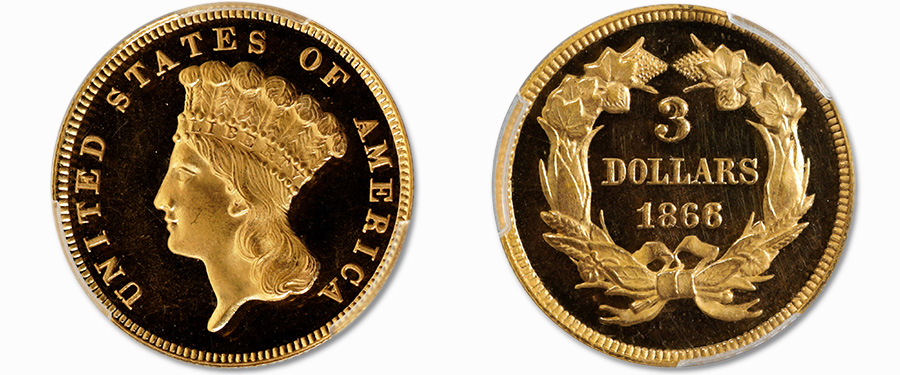
In 1866, the Mint produced a minuscule amount of Proof $3 gold pieces, just 30 in total. They struck 25 pieces on January 15 of that year and sprinkled in another five on June 8. Estimates range from 12 to 22 examples surviving today, with John W. Dannreuther’s 2018 estimate being on the lower end at 12 to 16 coins and PCGS opining that around 20 pieces remain. As a frame of reference, the mintage of the famous 1894-S dime was 24 and PCGS estimates 13 exist. ?
We are thrilled to present the finest known Proof 1866 three-dollar gold piece in our April 2022 Showcase Auction, offered as part of the magnificent Huberman Collection. This Proof-66 Deep Cameo (PCGS) (CAC) features exemplary field to device contrast with a soft and satiny golden-yellow luster. The color is consistent and balanced throughout the obverse, while the orange peel texture over much of the reverse gives even more character. It is the finest graded by PCGS and sits as the finest of only five 1866 Proofs that bear a CAC sticker. The beauty and grade are just the beginning for this incredible rarity. In the past 10 years, we have not handled any Proof 1866 $3 gold pieces, which illustrates the significance and scarcity of this issue.
This finest known $3 Proof rarity also claims an exceptional provenance, most notably to the Louis E. Eliasberg, Sr. Collection. This coin was acquired by our consignor in our Stack’s January 1986 sale and has been off the market since that time. Its earlier provenance is traced to such luminaries as Woodin, Elder, Clapp, and the aforementioned Eliasberg through our October 1982 sale of The United States Gold Coin Collection.
Only the strongest bids will be competitive when this classic Proof gold rarity, of superior quality and with a rich history, crosses the auction block in our Spring 2022 Official Auction for the Whitman Coin & Collectibles Expo. One fortunate enthusiast will be catapulted onto the numismatic map with the addition of this incredible coin to their cabinet. Here is an opportunity that comes around only once every decade or so, and specialists should be well prepared.





